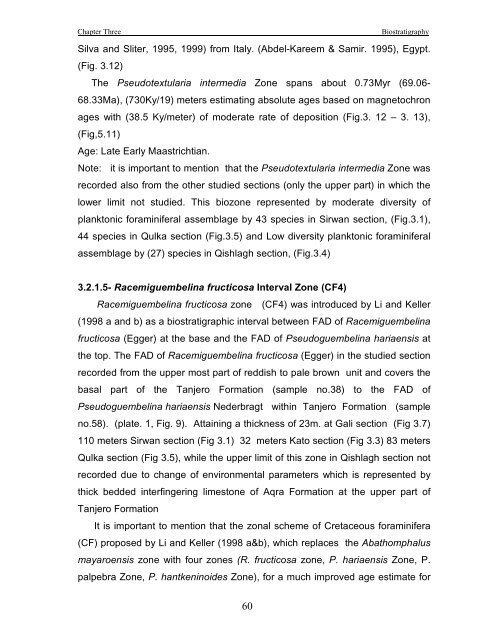biostratigraphy and paleoecology of cretaceous/tertiary boundary in ...
biostratigraphy and paleoecology of cretaceous/tertiary boundary in ...
biostratigraphy and paleoecology of cretaceous/tertiary boundary in ...
Create successful ePaper yourself
Turn your PDF publications into a flip-book with our unique Google optimized e-Paper software.
Chapter Three Biostratigraphy<br />
Silva <strong>and</strong> Sliter, 1995, 1999) from Italy. (Abdel-Kareem & Samir. 1995), Egypt.<br />
(Fig. 3.12)<br />
The Pseudotextularia <strong>in</strong>termedia Zone spans about 0.73Myr (69.06-<br />
68.33Ma), (730Ky/19) meters estimat<strong>in</strong>g absolute ages based on magnetochron<br />
ages with (38.5 Ky/meter) <strong>of</strong> moderate rate <strong>of</strong> deposition (Fig.3. 12 – 3. 13),<br />
(Fig,5.11)<br />
Age: Late Early Maastrichtian.<br />
Note: it is important to mention that the Pseudotextularia <strong>in</strong>termedia Zone was<br />
recorded also from the other studied sections (only the upper part) <strong>in</strong> which the<br />
lower limit not studied. This biozone represented by moderate diversity <strong>of</strong><br />
planktonic foram<strong>in</strong>iferal assemblage by 43 species <strong>in</strong> Sirwan section, (Fig.3.1),<br />
44 species <strong>in</strong> Qulka section (Fig.3.5) <strong>and</strong> Low diversity planktonic foram<strong>in</strong>iferal<br />
assemblage by (27) species <strong>in</strong> Qishlagh section, (Fig.3.4)<br />
3.2.1.5- Racemiguembel<strong>in</strong>a fructicosa Interval Zone (CF4)<br />
Racemiguembel<strong>in</strong>a fructicosa zone (CF4) was <strong>in</strong>troduced by Li <strong>and</strong> Keller<br />
(1998 a <strong>and</strong> b) as a biostratigraphic <strong>in</strong>terval between FAD <strong>of</strong> Racemiguembel<strong>in</strong>a<br />
fructicosa (Egger) at the base <strong>and</strong> the FAD <strong>of</strong> Pseudoguembel<strong>in</strong>a hariaensis at<br />
the top. The FAD <strong>of</strong> Racemiguembel<strong>in</strong>a fructicosa (Egger) <strong>in</strong> the studied section<br />
recorded from the upper most part <strong>of</strong> reddish to pale brown unit <strong>and</strong> covers the<br />
basal part <strong>of</strong> the Tanjero Formation (sample no.38) to the FAD <strong>of</strong><br />
Pseudoguembel<strong>in</strong>a hariaensis Nederbragt with<strong>in</strong> Tanjero Formation (sample<br />
no.58). (plate. 1, Fig. 9). Atta<strong>in</strong><strong>in</strong>g a thickness <strong>of</strong> 23m. at Gali section (Fig 3.7)<br />
110 meters Sirwan section (Fig 3.1) 32 meters Kato section (Fig 3.3) 83 meters<br />
Qulka section (Fig 3.5), while the upper limit <strong>of</strong> this zone <strong>in</strong> Qishlagh section not<br />
recorded due to change <strong>of</strong> environmental parameters which is represented by<br />
thick bedded <strong>in</strong>terf<strong>in</strong>ger<strong>in</strong>g limestone <strong>of</strong> Aqra Formation at the upper part <strong>of</strong><br />
Tanjero Formation<br />
It is important to mention that the zonal scheme <strong>of</strong> Cretaceous foram<strong>in</strong>ifera<br />
(CF) proposed by Li <strong>and</strong> Keller (1998 a&b), which replaces the Abathomphalus<br />
mayaroensis zone with four zones (R. fructicosa zone, P. hariaensis Zone, P.<br />
palpebra Zone, P. hantken<strong>in</strong>oides Zone), for a much improved age estimate for<br />
60

















